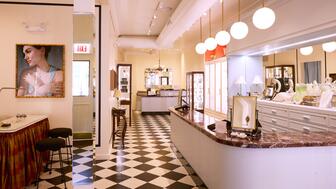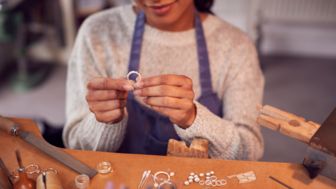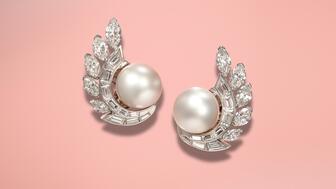Interior designer Athena Calderone looked to decor from the 1920s and 1930s when crafting her first fine jewelry collection.
I Was Invited to Dinner, But There Was No Food
Editor-in-Chief Michelle Graff recaps a jewelry event where a designer’s process was presented as a four-course meal.

On Monday night, I was invited to an event I approached with a bit of trepidation.
Organized by the women behind New York City Jewelry Week and art school Brooklyn Metal Works, it was a “Dinner” party that came with this disclaimer: “Edible dinner won’t be served, but drinks will be!”
Intrigued by the somewhat-ambiguous invitation and buoyed by the prospect of free drinks, I headed uptown a few blocks from my office to check out what this dinner without any food was all about.
What I found was a well-organized event in which I got to meet and learn from interesting people outside the jewelry world—something I think we should all do more of—and become immersed in a designer’s process from start to finish, but in a manner presented as a four-course meal.
The Setting
The dinner took place at R & Company, a New York City gallery that was hosting an exhibition of the same name.
R & Company’s “Dinner” was a celebration of the tradition of dining, with a mix of new and old table-and-chair sets and chandeliers set up on the gallery’s lower level, creating the perfect setting for the event—seven different (and beautiful, I might add) tables replete with seats.
Each of the seven jewelry designers featured had their own table, and there was no assigned seating; guests were welcome to sit at whichever table they liked.
Intrigued by a card that mentioned vintage viewfinders, I took a seat at the mid-century modern table where Philadelphia-based jewelry artist Melanie Bilenker was presenting her work.
Bilenker works out of the JV Collective art studio in South Philadelphia and sells her work—her own drawings recreated in hair and then incorporated into one-off pieces—online and through museums and exhibitions nationwide.
Some of her work also pays homage to souvenir viewfinders, those four-sided, mini-telescope-like picture holders you get as mementos of trips to amusement parks and other major tourist attractions.
The ‘Meal’
Much to my delight, the first course of my dinner/not dinner at Bilenker’s table consisted of the aforementioned viewfinders.
A server brought the viewfinders to the table on the tray, as any waitress or waiter would with a first round of drinks or an appetizer.
The artist then proceeded to pass them around the table and explain how she loves the souvenirs because they preserve a moment in time, many of them happy ones.
For the second course, the artist distributed baseball card-sized versions of the drawing recreated in the final piece.
Then came the third course—bags of hair.
RELATED CONTENT: The History Behind … Victorian Mourning JewelryThough hair jewelry is definitely not for everyone, and bags of hair even less so, I found this course to be the most compelling because it reminded me of what we sometimes forget working in the industry day in and day out—that jewelry is really interesting and cool when explained properly. The average person knows little about it, but is keen to learn.
A few of the other guests seated at the table were blown away when Bilenker explained the historical use of hair in jewelry, which inspired her technique today—she creates a sketch from a photograph then recreates the drawings in hair, gluing strands to paper and then incorporating the tiny works of art into necklaces, pins and rings.
View this post on InstagramA post shared by Melanie Bilenker (@melaniebilenker) on Apr 29, 2017 at 6:11pm PDT
In case I am doing a crap job of explaining it (and I fear I might be), you can see one of Melanie’s rings above (pictured right) next to a Victorian lover’s eye, and below is the final course from Monday night’s event, the necklace that combines the previous three dishes.
The Leftovers
Now, I would not say that the finished piece I saw Monday night is something I personally would wear; it’s a little big for my taste. It also is probably not something a ton of retail stores would stock, as Melanie’s work definitely falls more into the category of art jewelry.
But that’s not the point.
The point is that I enjoyed learning about Melanie’s design process, how she gets from start to finish, and the others at the table did too. And I thought the format of the evening was clever—presenting the designers’ works in courses, like a meal, with the last course being the finished product.
I also liked getting to know the artist behind the work, and was particularly struck by something Melanie said when explaining why she decided to go into jewelry instead of creating her incredible drawings as wall art, which they easily could be.
She’s attracted to the personal nature of jewelry, she said—the fact that you have to get close to another individual to really look at their jewelry, and that they let you.
“It’s a very physical, intimate kind of interaction,” she told the table. “You have to get very close to see someone’s jewelry, in their personal space.”
To see more of Melanie’s work, visit her website or her Instagram, @melaniebilenker.
The second annual New York Jewelry Week is scheduled for Nov. 18-24 in various locations around the city.
For more information, visit the event website.
The Latest

During a call about its full-year results, CEO Efraim Grinberg discussed how the company is approaching the uncertainty surrounding tariffs.

The free program provides educational content for jewelry salespeople and enthusiasts to learn or refresh their diamond knowledge.

The feedback will be used to prepare other jewelers for the challenges ahead, the organization said.


The online sessions are designed to teach jewelers to use AI tools like ChatGPT and Claude to grow their business.

The opening marks the jewelry retailer’s first location in the Midwest.

Bench jewelers spend years honing their skills, Jewelers of America’s Certification validates their talents.

The “United in Love” collection offers tangible mementos of hearts entwined with traditional and non-traditional commitment heirlooms.

Robert Goodman Jewelers will hold a “Black Jewelry Designers and Makers” event on April 27.

The announcements follow a tumultuous start to 2025 for WJA, which saw a wave of resignations following controversial statements about DEI.

The historic fancy vivid blue diamond set to headline Christie’s Geneva sale next month could sell for up to $50 million.

LVMH CFO Cécile Cabanis also discussed the effects of tariffs so far.

The “Mad Men” and “The Morning Show” star steals jewelry, art, and handbags from his wealthy neighbors in “Your Friends & Neighbors.”

The organization has reelected Kalpesh Jhaveri as president.

An investigation found that the former managing director of Movado’s Dubai branch overstated and prematurely recorded sales.

The collection pays tribute to the Japanese philosophy of Ma, studying balance, stillness, and the interplay between presence and absence.

Mari Lou’s Fine Jewelry in Orland Park, a suburb of Chicago, is closing its doors.

GIA’s labs in Dubai and Hong Kong are now accepting larger diamonds in light of the “logistical challenges” presented by the new tariffs.

These earrings by Van Cleef & Arpels, featuring the same design as a pair worn by Princess Grace, are up for auction at Woolley & Wallis.

Two experts share how artificial intelligence tools can help retailers run a more efficient business.

Kentaro Nishimura, who has been with the pearl company since 1997, has been promoted to president and CEO of Mikimoto America.

“America Telling Time: 150 Years of Bulova” explores the storied history of the American watchmaker.

An across-the-board tariff of 10 percent remains in place for all U.S. trading partners, except China.

Brigette Pheloung and Tania Sarin, and their mothers, star in the campaign wearing medallions they co-designed.

LeVian is remembered for her unwavering commitment to her family, community, and helping others.

The retail show is open to the public and will run July 24-27.





























